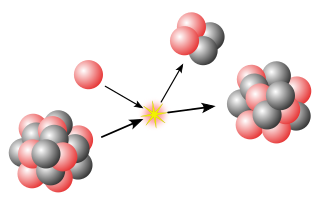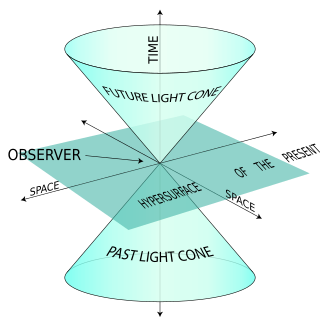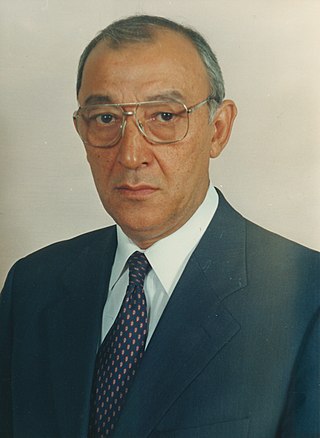The many-body problem is a general name for a vast category of physical problems pertaining to the properties of microscopic systems made of many interacting particles.

High-energy nuclear physics studies the behavior of nuclear matter in energy regimes typical of high-energy physics. The primary focus of this field is the study of heavy-ion collisions, as compared to lighter atoms in other particle accelerators. At sufficient collision energies, these types of collisions are theorized to produce the quark–gluon plasma. In peripheral nuclear collisions at high energies one expects to obtain information on the electromagnetic production of leptons and mesons that are not accessible in electron–positron colliders due to their much smaller luminosities.
Quark matter or QCD matter refers to any of a number of hypothetical phases of matter whose degrees of freedom include quarks and gluons, of which the prominent example is quark-gluon plasma. Several series of conferences in 2019, 2020, and 2021 were devoted to this topic.

The nuclear force is a force that acts between hadrons, most commonly observed between protons and neutrons of atoms. Neutrons and protons, both nucleons, are affected by the nuclear force almost identically. Since protons have charge +1 e, they experience an electric force that tends to push them apart, but at short range the attractive nuclear force is strong enough to overcome the electrostatic force. The nuclear force binds nucleons into atomic nuclei.

The European Physical Journal is a joint publication of EDP Sciences, Springer Science+Business Media, and the Società Italiana di Fisica. It arose in 1998 as a merger and continuation of Acta Physica Hungarica, Anales de Física, Czechoslovak Journal of Physics, Il Nuovo Cimento, Journal de Physique, Portugaliae Physica and Zeitschrift für Physik. The journal is published in various sections, covering all areas of physics.

Witold (Witek) Nazarewicz is a Polish-American nuclear physicist, researcher, and educator. He is a John A. Hannah Distinguished Professor in Physics and Chief Scientist at the Facility for Rare Isotope Beams (FRIB) and the Department of Physics and Astronomy at Michigan State University, and a Professor at the University of Warsaw, Faculty of Physics, Institute of Theoretical Physics.

Quark–gluon plasma is an interacting localized assembly of quarks and gluons at thermal and chemical (abundance) equilibrium. The word plasma signals that free color charges are allowed. In a 1987 summary, Léon Van Hove pointed out the equivalence of the three terms: quark gluon plasma, quark matter and a new state of matter. Since the temperature is above the Hagedorn temperature—and thus above the scale of light u,d-quark mass—the pressure exhibits the relativistic Stefan-Boltzmann format governed by temperature to the fourth power and many practically massless quark and gluon constituents. It can be said that QGP emerges to be the new phase of strongly interacting matter which manifests its physical properties in terms of nearly free dynamics of practically massless gluons and quarks. Both quarks and gluons must be present in conditions near chemical (yield) equilibrium with their colour charge open for a new state of matter to be referred to as QGP.
Sigurd Hofmann was a German physicist known for his work on superheavy elements.
Mannque Rho is a South Korean-French theoretical physicist. He has contributed to theoretical nuclear/hadron physics and suggested Brown-Rho Scaling with Gerald E. Brown which predicts how the masses of the hadrons disappear in hot and dense environments.
Reiner Kruecken is the Nuclear Science Division Director at Lawrence Berkeley National Laboratory. Before moving to LBNL in June 2022, he served as Deputy Director at TRIUMF, Canada's Particle Accelerator Centre. He joined TRIUMF in February 2011 after 8+1⁄2 years at the Technical University Munich, Germany, where he held the chair (C4) for Experimental Physics of Hadrons and Nuclei. From 2011 to 2015 Kruecken was the head of the Science Division at TRIUMF and he held a joint appointment as full professor in the Department of Physics and Astronomy at the University of British Columbia in Vancouver, Canada. Kruecken received his Ph.D. in nuclear physics from the University of Cologne in 1995. After a postdoctoral fellowship at Lawrence Berkeley National Laboratory he moved to Yale University in 1997, where he was an assistant professor at the Physics Department and the A.W. Wright Nuclear Structure Laboratory until he moved to Munich in 2002. His current research interests are in the area of the structure of exotic nuclei, nuclear astrophysics, as well as applications of nuclear physics methods to radiation biology and medicine. He is an adjunct professor at the University of British Columbia in Vancouver, Canada.

Boris Vladimirovich Struminsky was a Russian and Ukrainian physicist known for his contribution to theoretical elementary particle physics.
Achim Schwenk is a German physicist. He became a professor at the Institute of Nuclear Physics at the Darmstadt University of Technology in 2009.

The light-front quantization of quantum field theories provides a useful alternative to ordinary equal-time quantization. In particular, it can lead to a relativistic description of bound systems in terms of quantum-mechanical wave functions. The quantization is based on the choice of light-front coordinates, where plays the role of time and the corresponding spatial coordinate is . Here, is the ordinary time, is a Cartesian coordinate, and is the speed of light. The other two Cartesian coordinates, and , are untouched and often called transverse or perpendicular, denoted by symbols of the type . The choice of the frame of reference where the time and -axis are defined can be left unspecified in an exactly soluble relativistic theory, but in practical calculations some choices may be more suitable than others. The basic formalism is discussed elsewhere.

Kadyr Gafurovich Gulamov is an Uzbek politician who has served as Minister of Defence of Uzbekistan. To date, he was the first and only civilian leader of an Uzbek military department.
John William Negele is an American theoretical nuclear physicist.
Ulrich Mosel is a German theoretical physicist, professor emeritus at Justus-Liebig-Universität Giessen, Germany
Arthur Kent Kerman was a Canadian-American nuclear physicist, a fellow of the American Physical Society, Fellow of the American Academy of Arts and Sciences, and Fellow of the New York Academy of Sciences. He was a professor emeritus of physics at Massachusetts Institute of Technology's Center for Theoretical Physics (CTP) and Laboratory for Nuclear Science. He was known for his work on the theory of the structure of nuclei and on the theory of nuclear reactions.
Benson T. Chertok was professor of physics at The American University in Washington, D.C., a researcher in the field of high energy nuclear physics, and an advocate for arms control.
Shalom Shlomo is a nuclear physicist, academic, and author. He is a Senior Scientist and Group Leader at the Cyclotron Institute of the Texas A&M University (TAMU).







